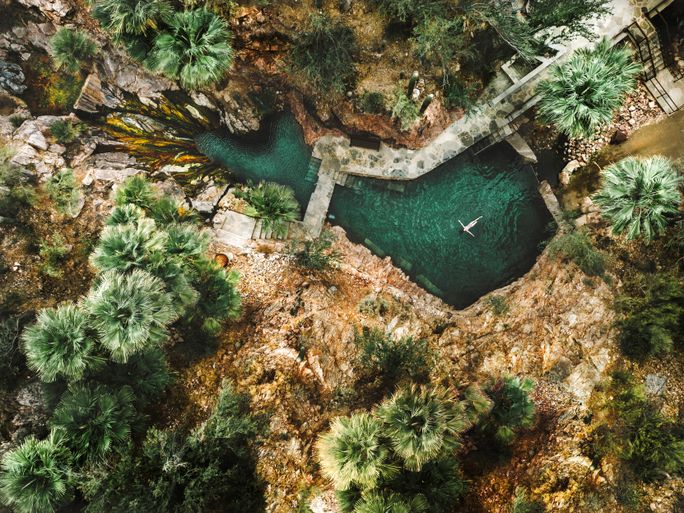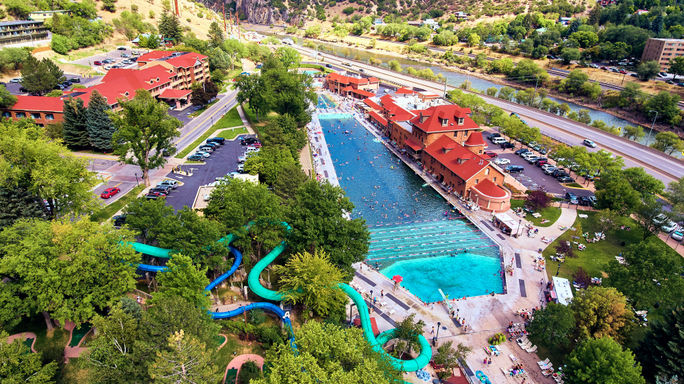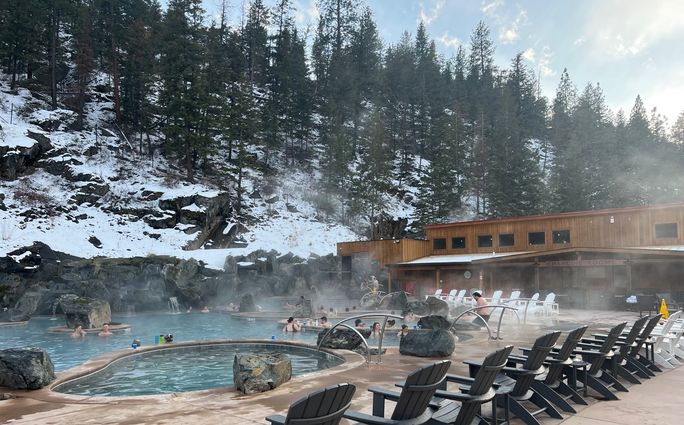If you’re into health, but have never been to a hot spring, you really should add this to your travel bucket wish list.
Hot springs are natural pools of geothermally heated water that emerge from the Earth's crust. They occur when groundwater is heated by hot rocks or magma beneath the Earth's surface and then rises back to the surface through cracks or fissures.
Temperatures vary from lukewarm to boiling hot with safe soaking temperatures ranging from 90 to 110 degrees Fahrenheit.
Many hot springs contain minerals like calcium, magnesium, sulfur and silica, which create water healing or therapeutic properties. This is why hot springs are associated with spas and wellness retreats, offering a mix of natural beauty, relaxation and well-being.
Hot springs can differ from geothermal pools fed directly by hot springs, containing mineral-rich water. Geysers, like Old Faithful in Yellowstone periodically erupt with steam and boiling water and then there are thermal rivers, streams heated by geothermal activity, like the Boiling River in Yellowstone.
The Western part of the U.S. contains more hot springs because of unique geological activity and tectonic settings. These boundaries often feature volcanic activity, which heats the underground water.
Here are some great destinations where you can find these geothermal treasures.
Chena Hot Springs, Alaska
Located approximately 60 miles northeast of Fairbanks, the hot springs has become a popular destination for both relaxation and adventure. The added benefit is getting a glimpse of the aurora borealis or northern lights dancing across the sky as you soak in the wellness waters.
Established over a century ago, the resort offers a variety of lodging options, including rustic cabins, lodge rooms and family suites. Guests can enjoy the geothermal hot springs lake, indoor and outdoor hot tubs and heated indoor pools.
Chena Hot Springs utilizes geothermal energy for power, operating the first low-temperature binary geothermal plant in Alaska, significantly reducing energy costs and supporting the ongoing commitment to renewable energy.

Aerial view of the hot springs at Castle Hot Springs. (photo via Castle Hot Springs) (Photo Credit: (photo via Castle Hot Springs))
Castle Hot Springs, Arizona
Castle Hot Springs is an adults-only luxury resort and natural hot springs situated in the Bradshaw Mountains of Arizona, about 50 miles north of Phoenix.
The destination is known for its stunning desert scenery, lush palm groves and natural hot springs that have been used for centuries. The springs are the main attraction, with water temperatures hovering around 120 degrees Fahrenheit.
Guests can stay in private bungalows, cabins and sky view suites and participate in wellness programs that include yoga, meditation and spa treatments.
Calistoga, California
The hot springs of Calistoga heated by geothermal activity from nearby Mount St. Helena are rich in minerals such as magnesium, calcium and potassium. Water temperatures can reach up to 180 degrees Fahrenheit before being cooled for use in pools, baths and wellness treatments.
The most popular experiences in this thermal treasure trove in stunning Napa Valley include therapeutic mineral baths believed to improve circulation and relieve muscle tension and volcanic ash mud baths where guests are submerged in a mixture of volcanic ash, natural peat and mineral water, said to detoxify the body, reduce inflammation and soften skin.

Hot Springs Arkanas in winter (Patrick Finnegan / Flickr)
Hot Springs, Arkansas
This southern destination was established as a federal reservation in 1832, making it one of the oldest protected areas in the U.S. It became a national park in 1921 and features Bathhouse Row, a collection of eight historic bathhouses with stunning architecture.
The area features thermal water baths, thermal pools, private baths and steam caves. Interestingly enough, in the early 20th century, Hot Springs became a popular resort destination for celebrities, gangsters and baseball players. Al Capone and Babe Ruth were two notable visitors.
Glenwood Hot Springs, Colorado
Glenwood Hot Springs is known for having one of the largest hot spring pools in the world. The resort features a massive outdoor pool filled with mineral-rich hot spring water kept at a comfortable year-round 90 to 93-degree temperature for the large pool and 104 for the smaller therapy pool.
The area also included a variety of luxurious treatments, massages and wellness services at the Spa of the Rockies and lodging options convenient to the pools and spa.

Glenwood Hot Springs Pool. (Photo Credit: Nicholas J. Klein/Adobe)
Ojo Caliente, New Mexico
This historic hot springs resort is located in northern New Mexico, about an hour north of Santa Fe. Ojo Caliente is one of the oldest natural health resorts in the U.S. with hot springs considered sacred by Native American tribes for thousands of years.
The mineral-rich springs containing iron, soda and lithia waters are believed to have various healing properties such as aiding digestion, boosting mood and bolstering the immune system. Guests can stay in a variety of adobe-style suites, retro cottages and a historic hotel, surrounded by hiking paths, bike trails and loads of warm soaking ponds.
Quinn’s Hot Springs Resort, Montana
Situated only an hour from the outdoorsy mecca of Missoula, Quinn’s Hot Springs Resort in Paradise is known for its scenic Bitterroot Mountain views, rustic charm and relaxing hot spring pools. In winter months, the mountains are topped with snow.
Located on the banks of the Clark Fork River, the resort showcases six natural mineral water pools, soaking pools and cooler swimming pools, all fed by natural hot springs.
Guests can stay in cabins ranging from luxury to rustic, including rive and mountain view options. The Glacier Lodge offers upscale accommodations with modern amenities.

The natural hot springs pools at Quinn's Hot Springs Resort. (photo by Kim Banocy)
Mammoth Hot Springs, Yellowstone National Park, Wyoming
This unique and stunning geothermal area is located in the northern part of Yellowstone National Park near the park’s North Entrance in Gardiner, Montana. Unlike other thermal features in the park, Mammoth Springs is known for its terraced and colorful tiered limestone travertine formations created by hot water from the Norris Geyser Basin dissolving limestone underground and then depositing calcium carbonate as it cools at the surface.
Though the water temperature at 180 degrees Fahrenheit is much too hot to soak in, the terraces are a sight to see and change depending on water flow, temperature and mineral distribution. Winter provides a striking contrast with the white snow amidst steaming formations.
Dunton Hot Springs, Colorado
This luxurious and remote hot spring resort is located in the San Juan Mountains of southwestern Colorado, about 20 miles from the town of Dolores.
The unique location, once an 1800s mining ghost town-turned-upscale-resort, offers visitors the chance to soak in natural, mineral-rich hot springs in a rustic yet upscale setting, with stunning mountain views. It’s a perfect blend of nature and comfort, offering a relaxing and peaceful escape.

Umpqua Hot Springs, Glide, Oregon
If you don’t mind a “clothing optional” hot spring experience, head to this geothermal spring located in the Umpqua National Forest in southwestern Oregon, near the North Umpqua River.
Perched on a rocky hillside, the hot spring is known for its terraced geothermal pools with stunning views of the surrounding lush moss-covered forest and river, making it a popular spot for hikers, nature lovers and hot spring enthusiasts. It's particularly picturesque during the fall and winter months when the cool air and hot water provide a dramatic contrast.
The spring's mineral-rich waters vary in temperature and the location is highly favored by photographers and nature lovers.
For the latest travel news, updates and deals, subscribe to the daily TravelPulse newsletter.
.png)
.png) 1 week ago
7
1 week ago
7








 English (US) ·
English (US) ·  Spanish (ES) ·
Spanish (ES) ·